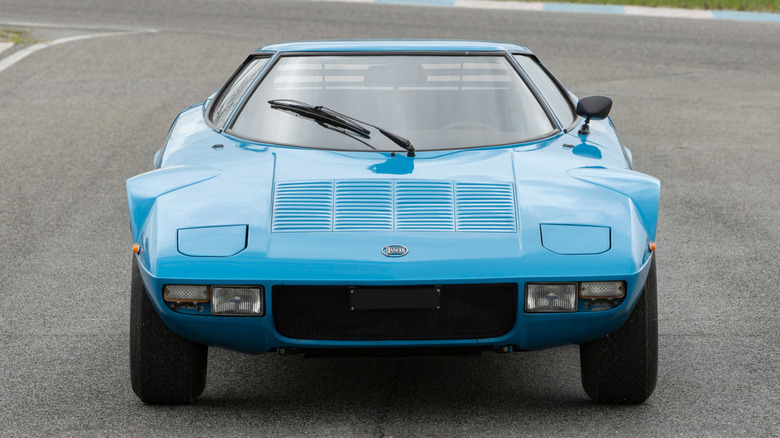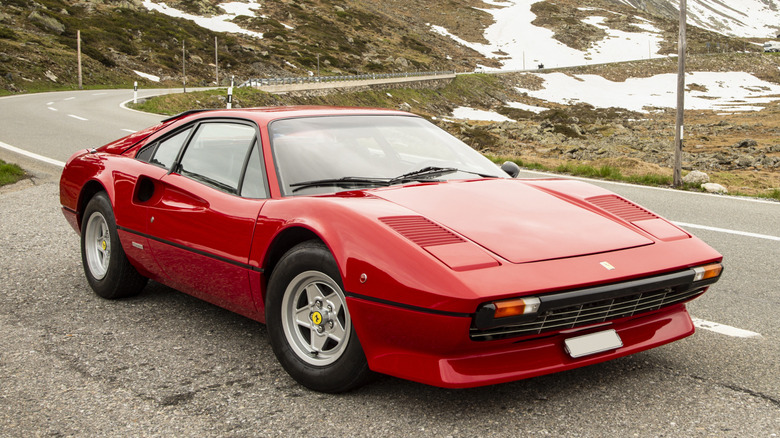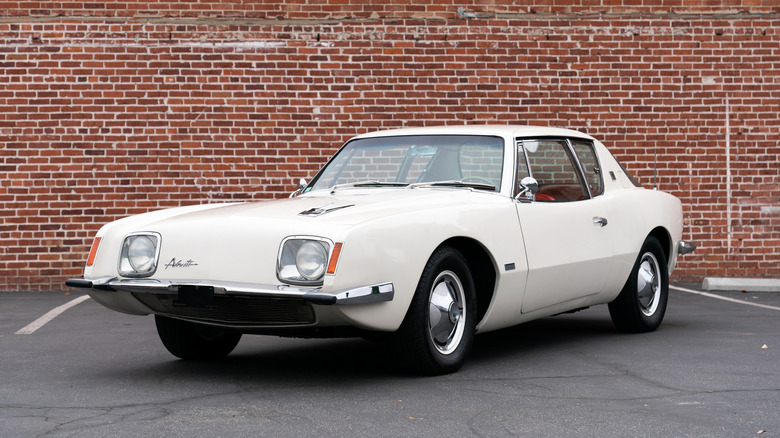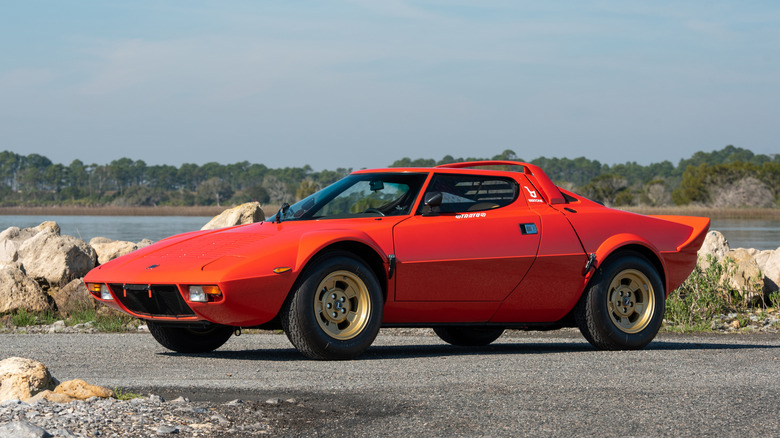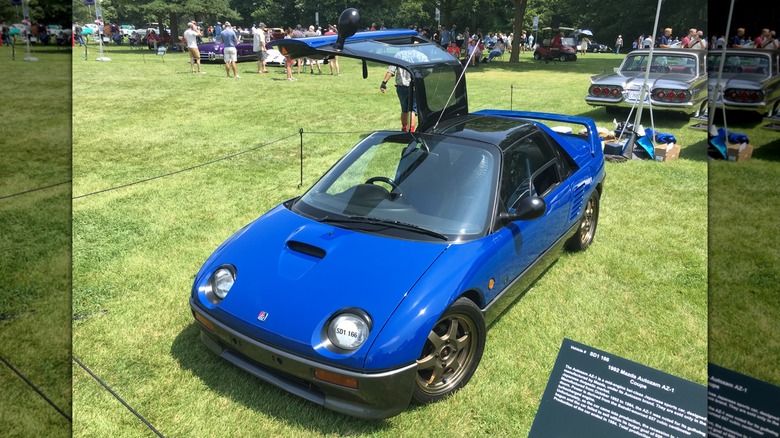5 Cars You Might Not Know Had Bodies Made Of Plastic
Plastic often gets a bit of a bad rap when it comes to cars — we're sure you've heard the word plasticky used to criticize a car's interior more than once — but the one-time wonder material has a lot going for it within the automotive space. That's especially true in any of its composite forms, such as glass-reinforced plastic (GRP). Just ask Chevrolet, which built early Corvettes out of fiberglass because it was cheap and lightweight, and in doing so, launched a dynasty of high-performance muscle and sports cars that endures to this day.
For all its negative connotations, plastic can be a great boon for car manufacturers that don't want to commit to the extra costs of using sheet metal, be it due to financial constraints or the need to get finished products out the door quickly and efficiently. Thus, many automakers over the years have opted to use some sort of fiberglass or GRP material in their vehicles. Some, like the Chevrolet Corvette, have become part of gearhead culture partly on the back of plastic bodies. But others haven't quite earned the same reputation, and thus, there are plenty of cars out there that you may not have realized were made out of plastic. Here are a small handful of those, ranging from a prestigious Ferrari to a quirky Japanese kei car — and a few in between.
Ferrari 308 GTB
Let's start with what is probably the most celebrated vehicle on this list, the Ferrari 308 GTB. Hailed by magazines like Car and Driver as "a remarkable machine ... one of the most logical, comfortable and easy-to-drive [mid-engined] cars ever built," the 308 GTB debuted in 1975 and very quickly became one of the most desirable cars of that year. This was despite sharing many of its components with the not-quite-a-Ferrari Dino 308 GT4.
The 308 GTB wasn't just a great car; It also has a couple of firsts to its name. It was the first modern mid-engined V8 Ferrari, kicking off a lineage that counts the all-time classic Ferrari F355 and hyper-modern electrified SF90 Stradale amongst its members. But it was also the Prancing Horse's first fiberglass — "vetroresina" in Italian — car, with the Italian automaker's use of the composite material reportedly a way of producing cars as quickly as possible. Happily for performance-oriented owners, the fiberglass also meant weight savings, with the early 308 GTBs weighing a modest 2,403 pounds.
Sources can't seem to agree on how many 308 GTB "Vetroresina" models Ferrari made during the car's first few years. Some sources suggest that 808 examples left the factory between 1975 and 1977, while others cite 712 as the number. Either way, one thing's for sure: The rarity means that plastic 308 GTBs command a significant price premium, with one example selling for a cool $313,000 at auction in 2023. Think about that next time you equate plastic with cheap.
BMW M1
Ferrari's 308 GTB isn't the only slab of European mid-engined exotica to opt for a plastic body. Enter the BMW M1, the German marque's failed attempt to break into Group 4 racing. Not that this failure had anything to do with the quality of the car, mind you. Rather, it was down to its convoluted production, with delays meaning that the M1 debuted only a few months before Group 4 was cancelled.
It was a shame, really, as by all accounts, the M1 was a remarkable vehicle. Contemporary reviews praised the car's suspension, engine, and even interior, with Car and Driver hailing the M1 as "the absolute pinnacle of hyperfast street cars" back in 1981. It seems to have held up very well, too, judging by more recent opinions. But even the best-engineered vehicle needs a bit of extra spice to enter the pantheon of all-time greats, and that's where the bodywork comes in.
The M1's fiberglass body is a thing of beauty, easily earning its place as one of the best cars ever designed by Giorgetto Giugiaro. If that name sounds familiar, it should: Giugiaro's CV includes all-time classics such as the DeLorean DMC-12, the first-gen Lotus Esprit, and the Lancia Delta. Built by Italian firm Trattamento Italiano Resina (TIR), the M1's folded-paper design and fiberglass body were every bit the equal of its mechanical parts, with reviews of the time highlighting TIR's high-quality handling of the material. As with so many greats, M1s are very rare, with BMW only ever building 460 examples.
Studebaker Avanti
We have one more Euro classic to discuss, but let's leave the Old World behind and turn our attention to the sole American offering here, the Studebaker Avanti. By the time the Avanti debuted in 1962, the historic brand was on its last legs. Despite surviving two world wars, an unfortunate merger with luxury automaker Packard sent Studebaker into a downward spiral from which it never recovered, despite its best efforts.
The Avanti was one of these efforts, the brainchild of then-president Sherwood H. Egbert and designer Raymond Loewy — and what an effort it was. Powered by naturally aspirated and supercharged versions of Studebaker's 289 cubic inch V8, the latter producing a healthy 290 hp, Studebaker marketed the Avanti as "America's most advanced automobile," thanks to features such as front disc brakes, a limited-slip differential, and that signature aerodynamic bodywork.
Studebaker's financial pressures meant that the Avanti's fiberglass body was as much a question of practicality as it was of performance. Fiberglass didn't require as much setup time and cost as steel, which was good for a company short on time. That fiscal prudence extended to the underpinnings, with engineers modifying the chassis used in the Studebaker Lark for the Avanti. Unfortunately, the Avanti couldn't keep Studebaker afloat, and the company closed down in 1966. But Studebaker had sold the tooling to new owners in 1964, and they repackaged it as the Avanti II. Various proprietors kept the name and car going for the next few decades until legal trouble seemingly put an end to the story in 2007.
Lancia Stratos HF
Whenever car nerds talk about the most legendary rally cars ever, one name almost always comes up: Lancia. Founded (as Lancia & C. Fabbrica Automobili) in 1906, Lancia might not have the pop culture cachet of Ferrari or Lamborghini, but it more than makes up for it with its rallying heritage. It all started with the Lancia Fulvia HF and peaked with the all-conquering Delta Integrale, but there's little in Lancia's history that can challenge the Lancia Stratos' aesthetics.
A product of Marcello Gandini and Italian studio Bertone, the Lancia Stratos' radical fiberglass body had its roots in the wedge-shaped Lancia Stratos HF Zero concept car from 1970. While the Zero was delightfully impractical — its windscreen doubled as its only point of entry — the rally-going Stratos was anything but. Powered by a 280 hp Ferrari V6, the Stratos dominated the world of rallying for a few glorious years, winning 10 of the 15 races it took part in during the 1974 season and bagging the World Rally Constructor's Championship title in 1975 and 1976. Sadly, it had to make way for Fiat's rally offerings in 1978, but that didn't stop privateer drivers from piloting the Stratos to more race victories over the following years.
Like its rallying career, enthusiasts have taken it upon themselves to keep the Stratos' flame alive. With original Stratos HFs selling for around $500,000 or more, companies have stepped in to fill the void for less well-heeled rally fans. One such example is LB Specialist Cars, which offers a kit-car version of the Stratos known as the STR, GRP panels and all.
Autozam AZ-1
The cars we've discussed thus far have all been great in their own ways, and are undoubtedly fun to drive, but we'd be pretty confident in saying that few are quite as joyously quirky as the last vehicle on our list, the Autozam AZ-1. One of the many classic kei cars from the JDM auto scene, the Autozam AZ-1 is likely one of the most eye-catching cars in a sea of charming little automobiles.
Let's put it this way: Who needs a practical city runaround to have gullwing doors, a mid-engined layout, and supercar styling? Nobody, really. But that's precisely what Mazda sub-brand Autozam — via Suzuki, which initially developed the car — brought to market in 1992. Drawing liberal inspiration from more than one high-performance Italian supercar, the AZ-1's plastic body matched its engaging personality and sharp steering, with Road & Track retrospectively calling the AZ-1 (and Honda NSX-R) "the very best of what Japan had to offer the mid-engine segment at the time."
Let's be clear, though: Even with its diminutive size and 1,590-pound curb weight, the AZ-1's 63 hp, 63 lb-ft turbocharged 660 cc engine will never have any serious performance car quaking in its boots — at least, not in a straight line. But that's not the point, really. The AZ-1 was a product conceived during the excesses of Japan's late-'80s boom economy, and the motoring world was all the better for it. Sadly, Mazda only sold 4,392 units during the AZ-1's short year-long production run, with the country's economic downturn in the 1990s likely partly to blame for poor sales.
